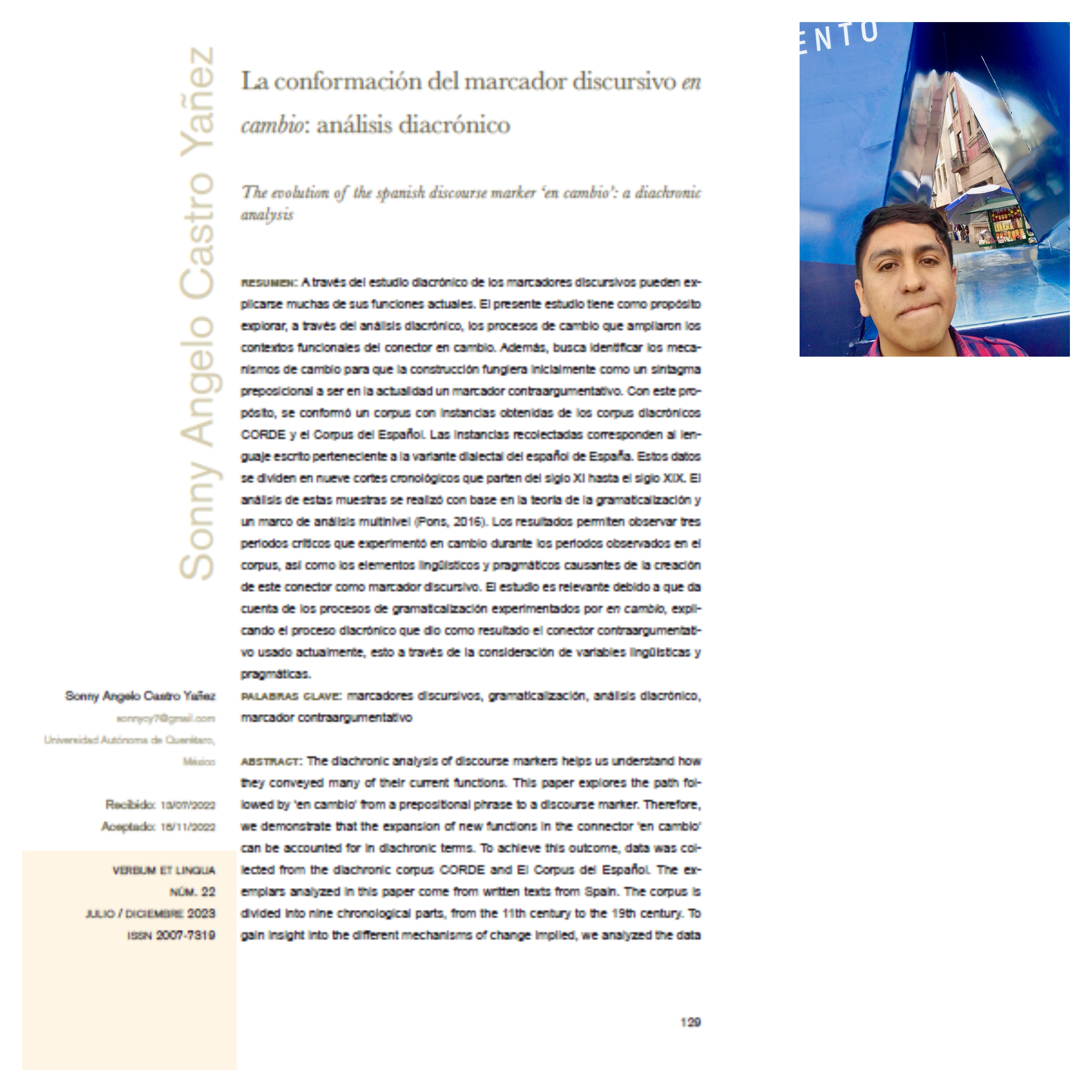La Conformación del Marcador Discursivo En Cambio: Análisis Diacrónico
DOI:
https://doi.org/10.32870/vel.vi22.214Parole chiave:
marcadores discursivos, gramaticalización, análisis diacrónico, marcador contraargumentativoAbstract
A través del estudio diacrónico de los marcadores discursivos pueden explicarse muchas de sus funciones actuales. El presente estudio tiene como propósito explorar, a través del análisis diacrónico, los procesos de cambio que ampliaron los contextos funcionales del conector en cambio. Además, busca identificar los mecanismos de cambio para que la construcción fungiera inicialmente como un sintagma preposicional a ser en la actualidad un marcador contraargumentativo. Con este propósito, se conformó un corpus con instancias obtenidas de los corpus diacrónicos CORDE y el Corpus del Español. Las instancias recolectadas corresponden al lenguaje escrito perteneciente a la variante dialectal del español de España. Estos datos se dividen en nueve cortes cronológicos que parten del siglo XI hasta el siglo XIX. El análisis de estas muestras se realizó con base en la teoría de la gramaticalización y un marco de análisis multinivel (Pons, 2016). Los resultados permiten observar tres periodos críticos que experimentó en cambio durante los periodos observados en el corpus, así como los elementos lingüísticos y pragmáticos causantes de la creación de este conector como marcador discursivo. El estudio es relevante debido a que da cuenta de los procesos de gramaticalización experimentados por en cambio, explicando el proceso diacrónico que dio como resultado el conector contraargumentativo usado actualmente, esto a través de la consideración de variables lingüísticas y pragmáticas.
Downloads
Metriche
Riferimenti bibliografici
Company, C. (2003). La gramaticalización en la historia del español. Medievalia, 35, pp. 1-62.
Croft, W. (2003). Typology and Universals. Cambridge: Cambridge University Press.
Fisher, K. (2006). Towards an understanding of the spectrum of approaches to discourse particles. En Kisher, K. (ed.). Approaches to discourse particles (pp. 1–20). Amsterdam: Elsevier.
Flores, D. (2019). Conformación de los marcadores discursivos en la historia del español: El caso de al contrario y a propósito. En La Interfaz Sintaxis-Pragmática (pp. 179-200). Berlin/Boston: DeGruyter.
Garachana, C., M. (1997). Los procesos de gramaticalización: una aplicación a los conectores contraargumentativos. España: Universidad de Barcelona (tesis doctoral).
Garachana, C., M. (2015). Teoría de la gramaticalización. Estado de la cuestión. En García, M., J., M. (Dir.). Congreso Internacional de Historia de la Lengua Española (pp. 331-360). España: Iberoamericana: Vervuert.
Garrido, R., M., C. (2006). Gramaticalización y marcadores del discurso: los contraargumentativos. Estudios humanísticos, 28, pp. 9-26.
Martín Zorraquino, M., A. (1998). Los marcadores del discurso desde el punto de vista gramatical. En Martín Zorraquino, M., A., &
Montolío, D., E. (Eds.). Los marcadores del discurso. Teoría y análisis (pp. 19-54). España: Arco Libros.
Martín Zorraquino, M., & Portolés, J. (1999). Los marcadores del discurso. En Bosque, I., & Demonte, V. (dirs.). Gramática descriptiva de la lengua española (pp. 4051-4213). Madrid: Espasa Calpe.
Pons, B., S. (2016). Evolución Diacrónica de o sea. BRAE, XCVI, pp. 291-350.
Pons Rodríguez, L. (2010). Los marcadores del discurso en la historia del español. En Lourdes, O., & Acín-Villa, E. (Eds.). Los estudios sobre marcadores del discurso en español, hoy (pp. 523-615). España: Arco Libros.
Portolés, L., J. (1995). Diferencias gramaticales y pragmáticas entre los conectores discursivo pero, sin embargo y no obstante. Boletín de la Real Academia Española, CLXV, pp. 231-269.
Portolés, J. (1998). Dos pares de marcadores del discurso: en cambio y por el contrario, en cualquier caso y en todo caso. En En Martín Zorraquino, M., A., & Montolío, D., E. (Eds). Los marcadores del discurso. Teoría y análisis (pp. 243-264). España: Arco Libros.
Portolés, J. (2016). Los marcadores del discurso. En Gutiérrez-Rexach, J. (ed.). Enciclopedia Lingüística Hispánica (pp. 689-699). Londres/Nueva York: Routledge.
REAL ACADEMIA ESPAÑOLA: Banco de datos (CORDE) [en línea]. Corpus diacrónico del español. <http://www.rae.es> [diciembre 2020]
REAL ACADEMIA ESPAÑOLA: Banco de datos (CREA) [en línea]. Corpus de referencia del español actual. <http://www.rae.es> [diciembre 2020]
REAL ACADEMIA ESPAÑOLA: Diccionario de la lengua española, 23.ª ed., [versión 23.4 en línea]. <https://dle.rae.es> [diciembre 2020].
Schiffrin, D. (2001). Discourse markers: language, meaning, and context. En E Tannen, D., Hamilton, E., H., & Schiffrin, D., (eds.). Handbook of Discourse Analysis (pp. 54-75). Oxford: Blackwell.
Traugott, E., C. (1995). The role of the development of discourse markers in a theory of grammaticalization. Artículo presentado en ICHL XII, pp. 1-23.
Vicente, E., & Foullioux, C. (1992). Los enunciados declarativos y la topicalización. Revista de Filología Francesa, 1, pp. 39-57.

Downloads
Pubblicato
Versioni
- 2024-08-30 (2)
- 2023-07-01 (1)












